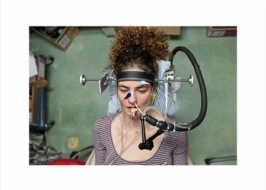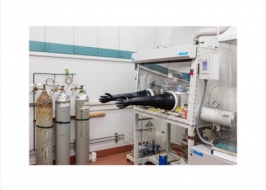"What a wonderful place"The David Lopatie Conference Centre1
Tomer Sapir, Thomas Struth, Martin Kollar, Kochav Kochavi and Wikimedia photographers
Four artists toured the Weizmann Institute of Science, as did a group of Wikimedia photographers. Something like scientists, each was trying to understand what is really happening here. But for scientists, the “here” they want to understand is the world; for the artists the question was focused on what, exactly, the scientists are doing. The sculptor Tomer Sapir, for example, built his installation Mother of All Wheat following a visit and discussions with scientists in in the Plant and Environmental Sciences Department, among others. The installation was created for Agro-Art: Contemporary Agriculture in Israeli Art, which was exhibited at the Petach Tikva Museum of Art and curated by Tali Tamir. Sapir presents a sort of combination greenhouse, research lab and plant gene depository that conserves, at least metaphorically, the “wisdom” of evolutionary survival that has been bred into wheat over thousands of generations of agriculture. Going back to the mother of all wheat – the original grass that gave rise to all our cultivated wheat today – Sapir creates new varieties and artificial mutations, hypothetical and imaginary. The installation suggests to us that there are genetic possibilities for “rebooting” the food chain that nourishes humanity, to better guard against future natural disaster or man-made ruin.
The German photographers Thomas Struth and Martin Kollar came to the Institute in the framework of a project initiated by the French-Jewish photographer Frédéric Brenner. Twelve photographers from different countries traveled around Israel, recording their impressions through their cameras’ lenses. The resulting exhibit, This Place, curated by Charlotte Cotton, was exhibited in DOX Center for Contemporary Art in Prague, the Brooklyn Museum in New York, the Norton Museum of Art in Miami, and the Tel-Aviv Museum of Art (Nili Goren curator).
Kochav Kochavi is a blind artist who completed his degree in the Art in the Community Program of Shenkar College, directed by Adi Yekutieli. Despite his handicap, or possibly because of it, he reminds us though his unconventional “frames” and the flashes of real life he captures that there are always new ways to absorb and process reality. By “seeing” though his lens, we are forced to reexamine such concepts as “correct” or “aesthetic.”
Rounding out the exhibit is the work of several volunteer photographers who are part of an effort to “cover” the entire world and to keep expanding our freedom of information – particularly the freedom of digital information – so that nothing of interest to a Wikipedia user will be hidden behind a wall.
Through the cameras of Struth, Kollar and Kochavi, and the Wikimedia group, as well as the Mother of All Wheat presented to us by Sapir, a wonderful place comes into focus. For these visitors, the labs are something like the old “curiosity cabinets” – rooms that gentlemen of leisure in past centuries would fill with exotica, both to preserve intriguing specimens or artifacts and to amaze their guests. We see their wonder, and this integrates, in a nearly synergistic way, with the questions that drive scientific research.
Y. A.






